How to prevent your baby from developing a flat head
What is it?
- Since the introduction of the “Back to Sleep” Program, the rate of Sudden Infant Death Syndrome (SIDS) has decreased. This is great news! Babies should always be placed on their back to sleep. However, because so many babies are now spending long periods of time on their backs, there has been an increase in the number of babies developing flat heads
- A baby’s skull bones are very soft and flexible. Their heads can be easily molded when left in one position for long periods of time
- This flattening of a baby’s skull is called positional plagiocephaly or brachycephaly
- When viewed from above, your baby may have a parallelogram shaped head with flattening on one side (plagiocephaly) or a flat spot on the back of the head (brachycephaly)
Plagiocephaly Brachycephaly



What causes some babies to develop a flat head?
- Babies who spend a lot of time lying on their backs or lying with their heads turned to one side (e.g. torticollis) are at risk for developing flat areas on their skulls.
- Some babies are born with these flat areas due to limited space in the womb.
- Premature babies have softer skull bones that can be more easily molded. This places them at an increased risk for developing flat areas.
Can having a flat head affect my baby’s growth?
In most cases, having a flat area will not affect brain growth or development. Having a flat head usually only affects a baby’s appearance. If untreated, it may cause the head and face to develop unevenly, especially the eyes, ears, nose, forehead, and jaw.
If a baby does not have enough tummy time, it can affect their development.
How can I help change my baby’s head shape?
Up until about 12 months of age a baby’s skull bones are very soft. During this time it is possible to improve head shape by using different strategies such as tummy time, exercises, and positional techniques.
Some families choose to have a custom molded helmet which can help reshape the skull. Helmets are made by an orthotist.
Starting these strategies early means a greater chance of improvement.
How do I prevent a flat head?
- Provide a lot of supervised tummy time when your baby is awake.
- Change your baby’s position frequently when they are awake and supervised.
- Once your baby has good head control you can start using a baby chair that does not support the head.
- Try to avoid or limit having your baby spend a lot of time in infant seats or swings, where your baby’s head is supported on the flat spot.
- Alternate the side on which you carry or hold your baby.
- Change the position of mobiles and other crib-safe toys in your baby’s crib, to encourage them to look in both directions.
- Alternate which end you baby’s head goes to when they are in the crib or on the change table lying on their back.
What can I do if my baby already has a flat head?
- Try the prevention strategies discussed in this brochure.
- Position your baby in a way that helps take the pressure off the flat areas of the skull. When your baby is awake and supervised, place a rolled blanket under your baby’s shoulder on the same side of the flat area. This will help keep your baby’s head turned away from the flat area.
- Try to avoid putting pressure on the flat areas of your baby’s head when holding and carrying your baby.
- Discuss with a specialist if helmet therapy would be a good option for your baby.
To make a referral to TVCC for therapy:
If you think you need intervention, you can contact our intake team to make a referral.





